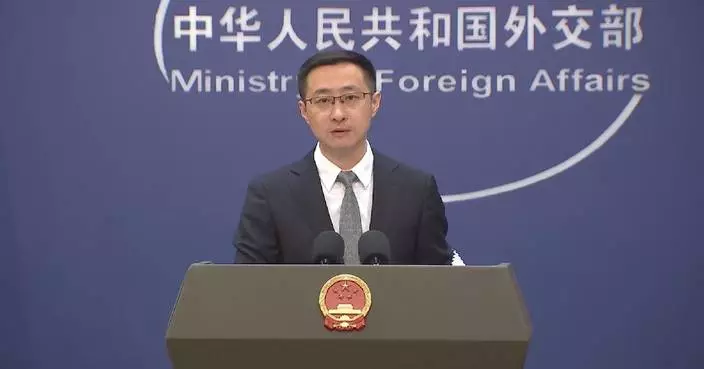Over the nearly past 25 years, the students from the Lion Dance Troupe at the University of Texas in Austin of the United States have been dedicated to practicing and performing traditional Chinese lion dancing to share this art form with and present Chinese culture to the local community.
Lion dance, a well-known traditional art form in Chinese culture, is currently being considered for inclusion on the UNESCO's cultural heritage list.
The Texas Dragon and Lion Dance Team (TDDT) was founded in 2000 with the aim of sharing the art of lion and dragon dance with people of all cultures. At the Austin campus of the University of Texas, this ancient Chinese tradition continues to thrive and attract members from diverse backgrounds.
"Maybe in the past, people would have seen martial arts or lion dance in general as more of an Asian thing. But over the years the U.S. has become more accepting of these things. It just brings together everybody with their different backgrounds," said Richard Huynh, a TDDT member.
The lion dance team effectively unites its members despite their varied cultural origins.
"Even though it's a team, it feels like a family. Like having people like stack on top of you, having to work together and aligning to make it as one like you become basically kind of as one," said another TDDT member Cole Stetson.
Now, the team has 25 active members of Chinese, Korean, Hispanic, and Vietnamese descent.
Taryn Champagne, the TDDT instructor, noted that the collaborative effort required for the challenging movements helps members bond.
"The importance is bringing people together. When you can share your culture with others, it helps build familiarity and bonds that oftentimes, last a lifetime. We struggle with all the same things. Whether it's the difficult stances, the challenging postures, lifts, all of that, you share in that experience together, and then not only you share in the experience of the difficulties, but also the successes," the instructor said.
Lion dance has been performed for over a thousand years in Asia. In the past few decades, it has gained increasing popularity abroad, including in the United States. China and Malaysia have jointly nominated it for UNESCO's intangible cultural heritage list, which will help demonstrate the diversity of the art and raise awareness about its importance worldwide.
"It carries the culture, it carries the history and the tradition. And all of that really is in there. And so we try to make sure that we honor the tradition while we're trying to hone our art," said TDDT member Richard Simental.

Lion Dance Troupe in US Texas university dedicated to presenting Chinese culture to locals
The Shanghai Pilot Free Trade Zone (FTZ) has created a benchmark for its peers nationwide with its streamlined customs clearance and government approvals, bringing slashed costs and speedier logistics for enterprises.
At Shanghai's largest cold chain logistics center for fruits, nearly 10,000 containers are imported annually from South America alone.
To keep tropical fruits fresh after traveling thousands of miles, a new international trade mechanism has been developed and perfected in the city's FTZ.
"Previously, foreign ships were not allowed to engage in coastal transport within China. So bananas from South America had to be routed through Busan, South Korea, before reaching the three major ports in north China. Now, with the FTZ allowing coastal transport by foreign vessels, bananas can be transferred directly from Yangshan Port to the three northern ports, reducing shipping time by one to two weeks and significantly cutting costs for companies," said Jiang Jianli, logistics director of Goodfarmer Foods Holding Group.
The Shanghai Port now handles over 49 million standard containers annually, or an average of 1.5 containers are processed per second.
Managing such a high volume of ships and goods while maintaining order requires advanced systems. A decade ago, companies had to physically submit piles of documents for customs. Now, the process has gone digital.
"The Shanghai International Trade Single Window links 22 regulatory departments, including customs and maritime affairs departments, into one platform. This provides businesses with one-stop service and automated real-time declarations around the clock," said Zhang Jie, deputy director of the Shanghai Municipal Commission of Commerce.
The system has reduced the time required for cargo declarations from one day to half an hour and for ship declarations from two days to two hours.
It now supports over one-quarter of China's foreign trade, facilitating the country's exports and imports. Items like Spanish ham, New Zealand honey, Mongolian cashmere, Syrian soap, Pakistani handicrafts, coffee beans from East Timor and international beauty brands now reach the Chinese market more quickly.
Trade facilitation in the FTZ has played a crucial role in the China International Import Expo (CIIE), held annually since 2018.
"Global products now become available in Shanghai instantly after they are launched, which is very convenient," said a local resident.
Businesses benefit from streamlined processes and consumers enjoy faster access to products, thanks to the government's proactive efforts.
The average approval time for business licenses has been cut by 90 percent, and the required application materials have been reduced by 70 percent.
More than 300 business-related approval items are now fully processed online, boosting innovation and entrepreneurship.
Beyond food and consumer goods, the FTZ has also made waves in the art world.
The Shanghai FTZ was the first to implement the system for temporary entry of cultural relics, doubling their permitted stay in China.
Artifacts can enter bonded warehouses within 24 hours of arrival and be displayed or traded across the country while under bonded status.
From 2013 to 2023, the total value of cultural relics and artworks entering and leaving the Shanghai FTZ reached over 100 billion yuan (more than 14. 16 billion U.S. dollars). The number of art pieces processed annually at the FTZ grew from less than 100 to more than 10,000.
In the Lingang New Area, a part of the FTZ, smart heavy-duty trucks, taxis, and buses have become part of daily life.
Five years ago, the first wholly foreign-owned vehicle manufacturing project in China was launched in Lingang, completing construction and starting production within the same year.
Since the establishment of the Lingang New Area five years ago, its GDP has grown by an average of 19.8 percent annually, industrial output of major businesses by 34.6 percent, and fixed asset investment by 33.4 percent.
The area has also attracted around 100,000 talents with an average annual hike of 97 percent.

Streamlined clearance at Shanghai Free Trade Zone sets benchmark for efficiency










